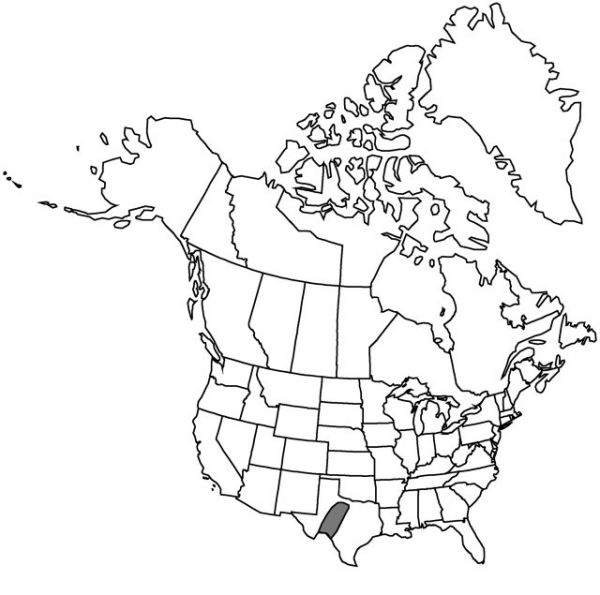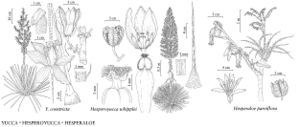Difference between revisions of "Hesperaloe parviflora"
Contr. U.S. Natl. Herb. 2: 436. 1894.
Common names: Red yucca red hesperaloe
Illustrated
Basionym: Yucca parviflora J. Torrey in W. H. Emory, Rep. U.S. Mex. Bound. 2(1): 221. 1859
Synonyms: Aloe yuccaefolia A. Gray Hesperaloe engelmannii Krauskopf Hesperaloe parviflora var. engelmannii (Krauskopf) Trelease Hesperaloe yuccaefolia
FNA>Volume Importer |
imported>Volume Importer |
||
| (2 intermediate revisions by 2 users not shown) | |||
| Line 8: | Line 8: | ||
}} | }} | ||
|common_names=Red yucca;red hesperaloe | |common_names=Red yucca;red hesperaloe | ||
| + | |special_status={{Treatment/ID/Special_status | ||
| + | |code=F | ||
| + | |label=Illustrated | ||
| + | }} | ||
|basionyms={{Treatment/ID/Basionym | |basionyms={{Treatment/ID/Basionym | ||
|name=Yucca parviflora | |name=Yucca parviflora | ||
| Line 44: | Line 48: | ||
|phenology=Flowering late winter–early summer. | |phenology=Flowering late winter–early summer. | ||
|habitat=Prairies, rocky slopes, and mesquite thickets | |habitat=Prairies, rocky slopes, and mesquite thickets | ||
| − | |elevation= | + | |elevation=0–600 m |
|distribution=Tex.;Mexico (Coahuila). | |distribution=Tex.;Mexico (Coahuila). | ||
|discussion=<p><i>Hesperaloe parviflora</i> is widely cultivated in arid and semiarid regions, both as roadside plantings and as landscaping elements.</p> | |discussion=<p><i>Hesperaloe parviflora</i> is widely cultivated in arid and semiarid regions, both as roadside plantings and as landscaping elements.</p> | ||
| Line 63: | Line 67: | ||
|phenology=Flowering late winter–early summer. | |phenology=Flowering late winter–early summer. | ||
|habitat=Prairies, rocky slopes, and mesquite thickets | |habitat=Prairies, rocky slopes, and mesquite thickets | ||
| − | |elevation= | + | |elevation=0–600 m |
|distribution=Tex.;Mexico (Coahuila). | |distribution=Tex.;Mexico (Coahuila). | ||
|reference=None | |reference=None | ||
|publication title=Contr. U.S. Natl. Herb. | |publication title=Contr. U.S. Natl. Herb. | ||
|publication year=1894 | |publication year=1894 | ||
| − | |special status= | + | |special status=Illustrated |
| − | |source xml=https:// | + | |source xml=https://bitbucket.org/aafc-mbb/fna-data-curation/src/2e0870ddd59836b60bcf96646a41e87ea5a5943a/coarse_grained_fna_xml/V26/V26_914.xml |
|genus=Hesperaloe | |genus=Hesperaloe | ||
|species=Hesperaloe parviflora | |species=Hesperaloe parviflora | ||
Latest revision as of 21:18, 5 November 2020
Leaf blades dark green, barely constricted along length, 5–12.5 × 0.1–0.25 dm, margins with slender threads. Panicles 1–2.5 m. Flowers: perianth narrowly tubular; tepals rosy red to salmon, 2.5–3.5 cm. Capsules 2.5–3 cm. Seeds 9–10 × 6–7 mm.
Phenology: Flowering late winter–early summer.
Habitat: Prairies, rocky slopes, and mesquite thickets
Elevation: 0–600 m
Distribution

Tex., Mexico (Coahuila).
Discussion
Hesperaloe parviflora is widely cultivated in arid and semiarid regions, both as roadside plantings and as landscaping elements.
Selected References
None.
Lower Taxa
None.
